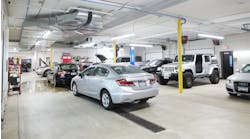Historic tires from past space shuttle missions are being made available from NASA for public display, and tire dealers are perfectly positioned to help launch a quest to participate on behalf of a civic organization in your community.
NASA spokeswoman Sonja Alexander tells Tire Topics that officials from the National Aeronautic and Space Administration are eager to make these unique, out-of-this-world tires available to various non-profit entities throughout the country. In the past, space shuttle tire distribution was largely restricted to museums and other educational institutions with limited access to the general public.
Wider exposure, education and outreach have been adopted as key goals, Alexander explains. “We’re looking for people out of the ordinary” museum circles to set up a local display featuring a shuttle tire.
Recreation centers, day camps and community groups of all types are invited to submit tire requests, preferably destined for “some event where there would be a lot of children,” she says.
Alexander suggests that a local tire dealer can perform an important civic contribution – and achieve positive publicity in the process – by taking the lead in pursuing liftoff for this mission.
“You can become the forefront,” she says, “come together as a group” in your town to make the project happen. “You have to move fast,” Alexander continues, citing a June 11 deadline for submitting applications through http://artifacts.nasa.gov.
Under NASA’s new Artifact Loan Opportunities Program, the space shuttle tires are “available to proposing organizations that NASA determines best meet the agency’s education and public outreach goals,” she notes.
“This new program gives organizations that are not traditionally associated with the agency the chance to have access to NASA artifacts. The shuttle tires and future available artifacts represent NASA’s many decades of exploration and discovery,” Alexander adds.
“The long-term loan of these tires may be used to educate, inspire or inform the public about NASA’s scientific and technological achievements through art, sculpture, furniture, building structures, exhibits or other innovative uses of the artifacts,” she observes.
Michelin Aircraft Tire Corp. has been the sole supplier of space shuttle tires since the program launched in 1981. A line of Michelin Air tires was introduced to the general civilian aviation market in 1992.
Shuttle tires undergo extensive testing to ensure that they can support a shuttle landing at speeds of up to 250 miles per hour, according to Dick Scholtz, a Michelin aircraft tire engineer directly involved with the missions. In addition to the routine checks common for all aircraft tires, space shuttle tires must also be examined by X-ray analysis and be further tested against NASA’s own stringent standards before being mounted on the craft and given the A-OK for launch.
“Surprisingly, a space shuttle tire is not much larger than a truck tire, but a main landing gear tire can carry three times the load of a Boeing 747 tire or the entire starting line-up of a NASCAR race - 40 race cars - all hitting the pavement at up to 250 miles per hour,” he notes.
The four main landing gear tires are 44.5x16.0-21, 34 ply, rated at 263 mph. The two nose landing gear tires are 32x8.8, 20 ply, rated at 250 mph.
The main landing gear shuttle tires are only used one time and the nose landing gear tires are used for two landings. All are produced at a plant in Norwood, N.C.
Shuttle tires are filled with nitrogen (as are most aircraft tires) due to its stability at different altitudes and temperatures. Due to the extremely heavy load of some 142,000 pounds of spacecraft, the bias ply tires riding on 21-inch wheels are inflated to 340 psi for the main gear and 300 psi for the nose gear, according to Scholtz.
By comparison, truck tires rated at 69 mph and weighing 194 pounds are typically inflated to 125 psi, while 165-pound earthmover tires rated at 30 mph are inflated to 55 psi.
Shuttle tires weigh 205 pounds. “Since weight is of extreme importance, Michelin designs the tires with a minimum amount of tread to conserve weight, allowing for larger payloads,” says Scholtz. “A few pounds may not seem to make much difference, but when you add up all of the ways to decrease weight throughout the shuttle it can have a significant impact.”
Goodyear is working with the NASA Glenn Research Center (GRC) in Cleveland to develop non-pneumatic tires for use first on the moon and then eventually on Mars.
Because of the unique atmospheric characteristics of the outer space operational environment, “The basic rubber-pneumatic design used on Earth does not have the same utility on the moon,” says NASA Principal Investigator Vivake Asnani. “The challenges associated with creating a lunar tire are further complicated by the fact that there are no lunar roads. Lunar tires need to be designed to develop traction on sandy undulated terrain, in regions that humans have never even seen up close. Plus, the prospect of an immobilizing ‘flat tire’ would be devastating to the mission.”
Vivake is a founding member of the Surface Mobility Technology team at GRC that was created in late 2005 in response to the announcement by President Bush in 2004 that the United States would embark on an initiative to further explore the moon and Mars.
Goodyear was selected to work with GRC because of its experience in previous lunar programs, understanding of vehicle dynamics and state-of-the-art computer modeling capabilities, according to Vivake.
“The mission performance goals for these tires will push known tire technology well beyond its comfort zone,” says Joe Gingo, Goodyear’s executive vice president and chief technical officer.
“Not only will the outcome of this project deliver a product that can handle the performance capabilities required for lunar mobility and beyond, we expect the outcome will yield answers to how future non-pneumatic tires may be designed for Earth applications,” explains Goodyear Principal Investigator Dave Glemming.
Over the past year, engineers have been evaluating the Apollo lunar rover wheel, prototype pneumatic tires and non-pneumatic concepts to build a baseline understanding of the mechanics of these wheels and the challenges of the lunar environment.
While the NASA one-year timeline to develop and demonstrate something as novel as a lunar tire seems extremely aggressive, the group is building on technology from the first moon landing, Glemming says. In the 1960s, NASA funded more than 10 years of intensive research at Goodyear and General Motors to develop the wire mesh moon tire for the Apollo Lunar Roving Vehicle (LRV).
The LRV tire was woven out of piano wire in order to provide a soft, springy surface to contour to the ground and provide good ride quality. It looks a bit like the skeleton of an Earth tire. This approach worked well, according to Glemming, because each LRV tire was only required to support about 60 pounds of weight (all things weigh 6-times less on the moon than on Earth) and be used for a maximum of 75 miles.
The new fleet of lunar vehicles will require tires to support about 10 times the weight and last for up to 100 times the distance. A tire that can meet such requirements would also be useful for commercial applications on Earth, Glemming points out.
To extend the utility of this wire mesh tire, the team is first analyzing the original design using computer modeling tools. Exact replicates of the tires are being manufactured and tested to find out how and why their load and life are limited. Essentially, the tires will be loaded and cycled until they fail. The Goodyear tire designers and research engineers at NASA GRC will then design, build and laboratory-test concept tires to mitigate the failures. The exact nature of these design changes has not yet been disclosed.
Following in the NASA tradition, says Glemming, everything will be proven and nothing taken for granted. A set of 12 tires will be built by winter of 2009 and demonstrated on the new NASA Chariot roving vehicle at the Johnson Space Center in Texas.
For more information, visit http://artifacts.nasa.gov, www.airmichelin.com, http://robonaut.jsc.nasa.gov/chariot or www.goodyear.com/corporate.


